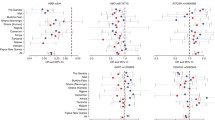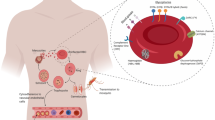Abstract
GLUCOSES-PHOSPHATE dehydrogeiiase (G6PD) deficiency, the most common enzymopathy of humans, affects over 400 million people1. The geographical correlation of its distribution with the historical endemicity of malaria suggests that this disorder has risen in frequency through natural selection by malaria2,3. However, attempts to confirm that G6PD deficiency is protective in case-control studies of malaria have yielded conflicting results4‡-8. Hence, for this X-linked disorder, it is unclear whether both male hemizygotes and female heterozygotes are protected or, as frequently suggested, only females1,5‡-11. Furthermore, how much protection may be afforded is unknown. Here we report that, in two large case-control studies of over 2,000 African children, the common African form of G6PD deficiency (G6PD A‡-) is associated with a 46‡-58% reduction in risk of severe malaria for both female heterozygotes and male hemizygotes. A mathematical model incorporating the measured selective advantage against malaria suggests that a counterbalancing selective disadvantage, associated with this enzyme deficiency, has retarded its rise in frequency in malaria-endemic regions. Although G6PD deficiency is now regarded as a generally benign disorder, in earlier environmental conditions it could have been significantly disadvantageous.
Similar content being viewed by others
References
Beutler, E. Semin. Haemat. 27, 137–164 (1990).
Allison, A. C. Nature 186, 531–532 (1960).
Motulsky, A. G. Hum. Biol. 32, 28–62 (1960).
Gilles, H. M. et al. Lancet I, 138–140 (1967).
Bienzle, U., Ayeni, O., Lucas, A. O. & Luzzato, L. Lancet I, 107–110 (1972).
Martin, S. K., Miller, L. H. & Alling, D. Lancet I, 524–526 (1979).
Luzzatto, L. & Bienzle, U. Lancet I, 1183–1184 (1979).
Miller, L. H. in Malaria. Principles and Practice of Malariology (eds Wernsdorfer, W. H. & McGregor, I. A.) 493–494 (Churchill Livingstone, Edinburgh, 1988).
Luzzatto, L. & Battistuzzi, U. Adv. med. Genet. 14, 217–329 (1985).
Greene, L. Yb. phys. Anthrop. 36, 153–178 (1993).
Martin, S. K. Parasit. Today 7, 251–252 (1994).
Hirono, A. & Beutler, E. Proc. natn. Acad. Sci. U.S.A. 85, 3951–3954 (1988).
Vulliamy, T. et al. Proc. natn. Acad. Sci. U.S.A. 88, 8568–8571 (1991).
Beutler, E. et al. Blood 7, 2550–2555 (1989).
Luzzatto, L. & Mehta, A. in The Metabolic Basis of Inherited Diseases (eds Scriver, C. R., Baudet, A. L., Sly, W. S. & Valle, D.) 2237–2265 (McGraw-Hill, 1989).
Usanga, E. A. & Luzzatto, L. Nature 313, 793–795 (1985).
Ling, I. T. & Wilson, R. J. M. Molec. Biochem. Parasit. 31, 47–56 (1988).
Kurdi-Haidar, B. & Luzzatto, L. Molec. Biochem. Parasit. 41, 83–92 (1990).
Greenwood, B. M., Marsh, K. & Snow, R. W. Parasit. Today 7, 277–281 (1991).
Marsh, K. Parasitology 104, S53–S59 (1992).
Hill, A. V. S. et al. Nature 352, 595–560 (1991).
McGuire, W., Hill, A. V. S., Allsopp, C. E. M., Greenwood, B. M. & Kwiatkowski, O. Nature 371, 508–511 (1994).
Hill, A. V. S. Trans. R. Soc. trop. Med. Hyg. 86, 225–232 (1992).
Roth, E. F., Raventos-Suarez, C., Rinaldi, A. & Nagel, R. L. Proc. natn. Acad. Sci. U.S.A. 80, 298–292 (1983).
Greenwood, B. M. et al. Trans. R. Soc. trop. Med. Hyg. 81, 478–486 (1987).
Bruce-Chwatt, L. J. in Malaria. Principles and Practice of Malariology (eds Wernsdorfer, W. H. & McGregor, I. A.) 1–60 (Churchill Livingstone, Edinburgh, 1988).
Livingstone, F. B. Frequencies of Hemoglobin Variants (Oxford Univ. Press, 1985).
Motulsky, A. G. Lancet I, 1168–1169 (1961).
Heller, P., Best, W. R., Nelson, R. B. & Becktel, J. New Engl. J. Med. 300, 1001–1008 (1979).
Author information
Authors and Affiliations
Rights and permissions
About this article
Cite this article
Ruwende, C., Khoo, S., Snow, R. et al. Natural selection of hemi- and heterozygotes for G6PD deficiency in Africa by resistance to severe malaria. Nature 376, 246–249 (1995). https://doi.org/10.1038/376246a0
Received:
Accepted:
Issue Date:
DOI: https://doi.org/10.1038/376246a0
- Springer Nature Limited
This article is cited by
-
Prevalence of G6PD deficiency and submicroscopic malaria parasites carriage in malaria hotspot area in Northwest, Tanzania
Malaria Journal (2023)
-
The pentose phosphate pathway in health and disease
Nature Metabolism (2023)
-
Duffy blood system and G6PD genetic variants in vivax malaria patients from Manaus, Amazonas, Brazil
Malaria Journal (2022)
-
Glucose-6-phosphate dehydrogenase mutations in malaria endemic area of Thailand by multiplexed high‐resolution melting curve analysis
Malaria Journal (2021)
-
Associations between red blood cell variants and malaria among children and adults from three areas of Uganda: a prospective cohort study
Malaria Journal (2020)





